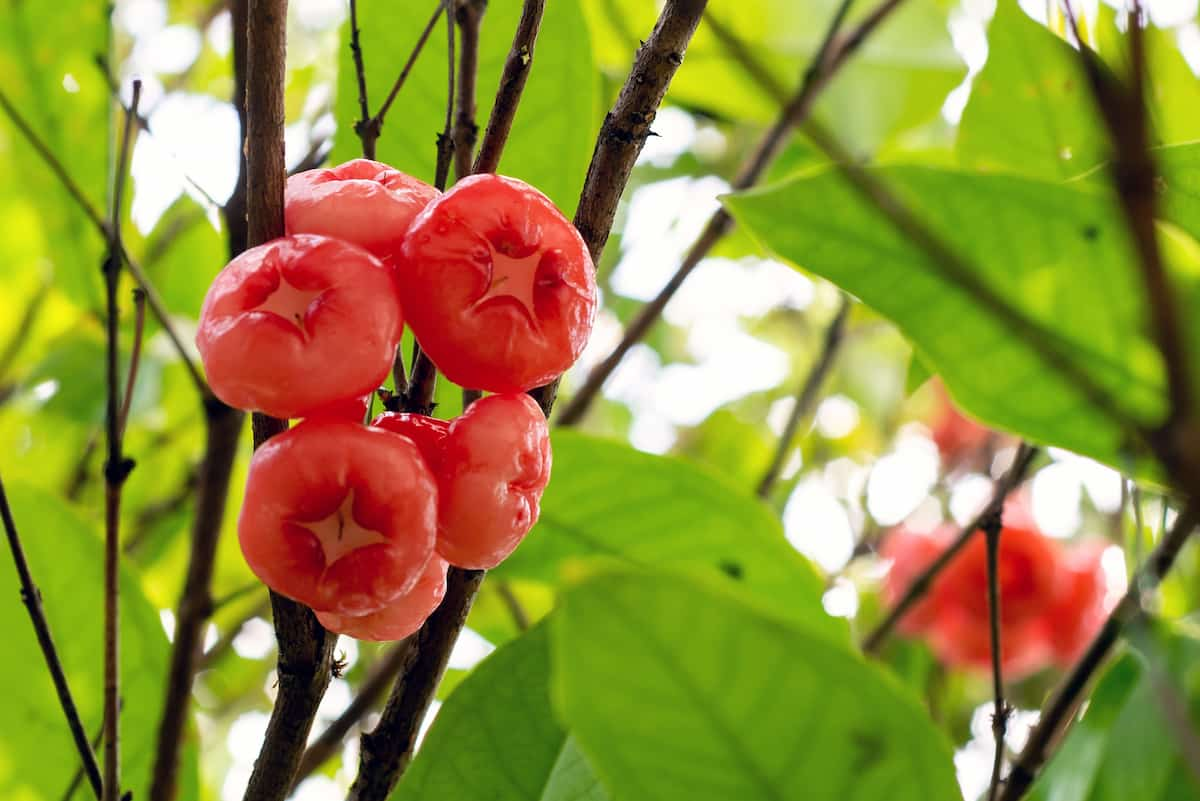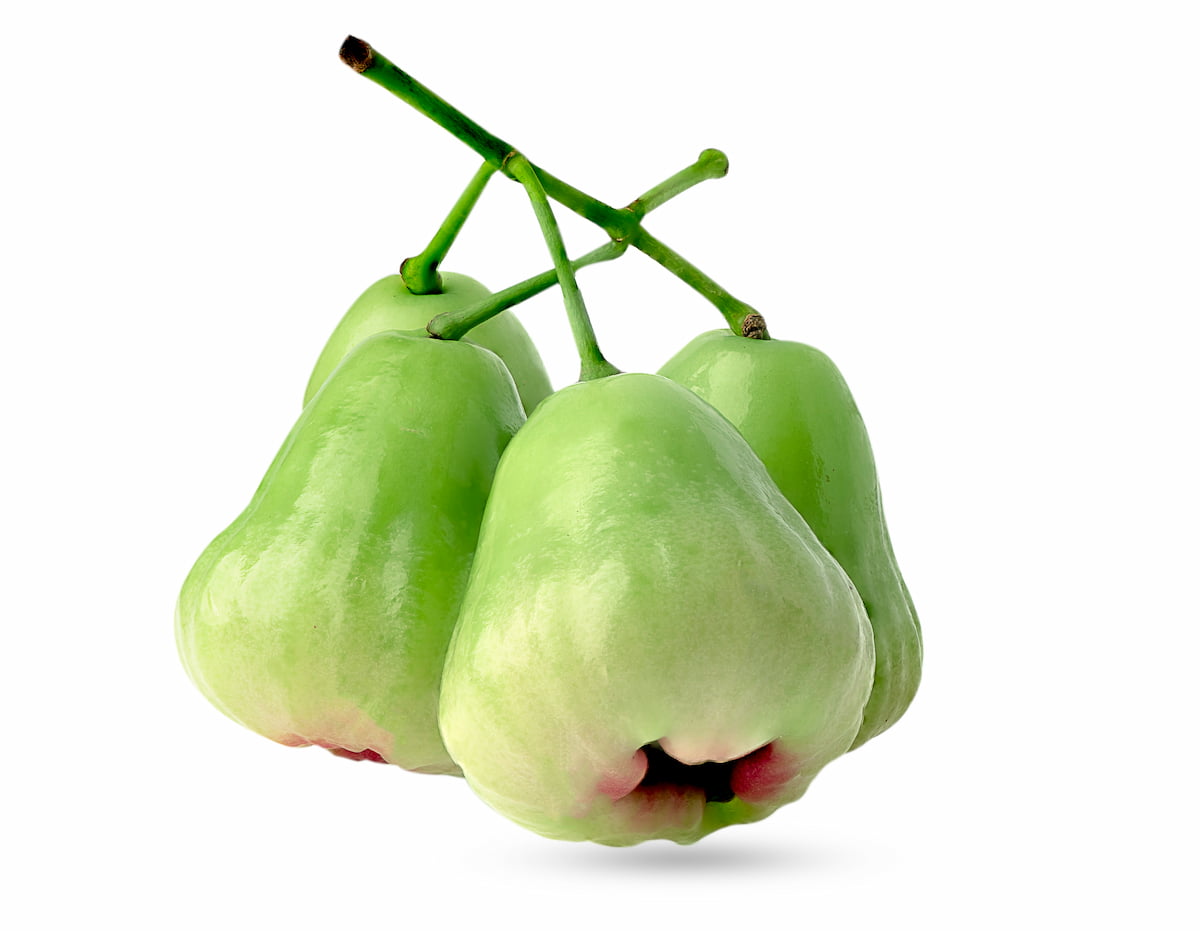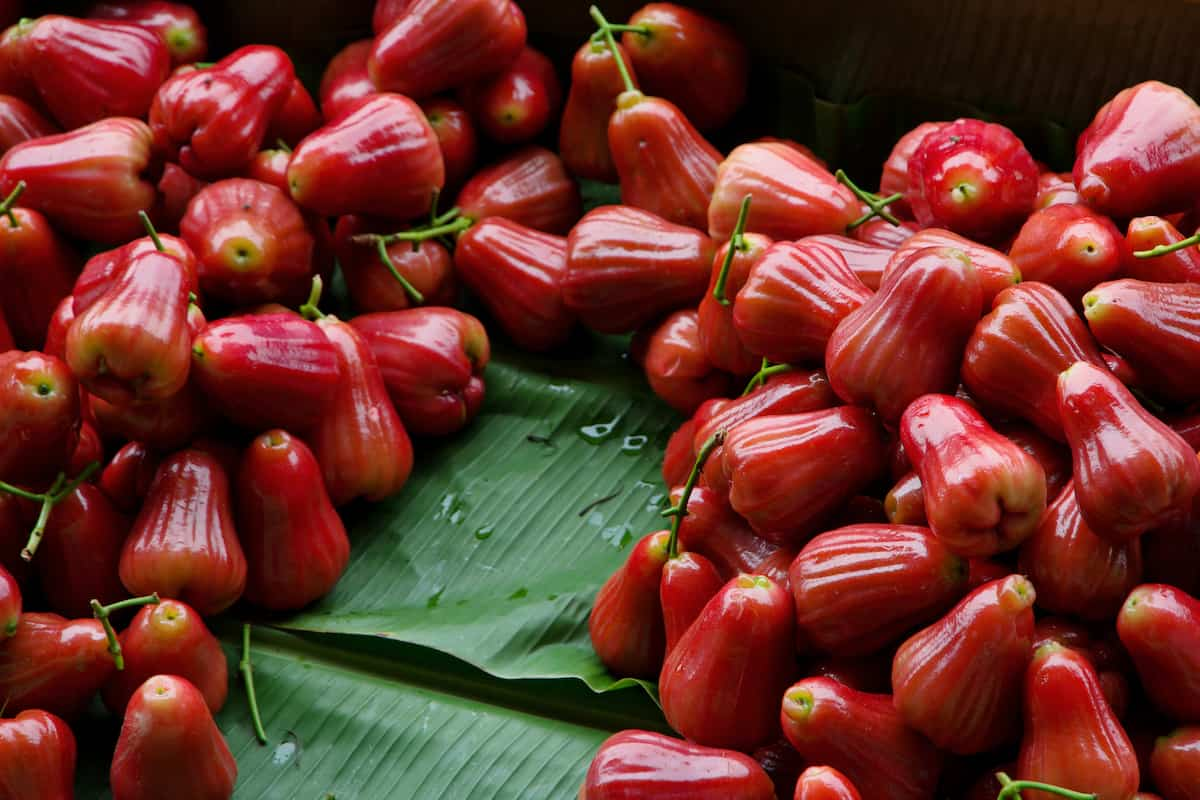Rose Apple, also known as Wax Apple, Java Apple, or Water Apple, is a tropical fruit tree. The fruit, native to Southeast Asia, is known for its unique shape, crisp texture, and mildly sweet flavor. Growing rose apple from seed is an exciting and rewarding process, and with the right care and attention, you can cultivate a beautiful, fruit-bearing tree. Below we learn how to grow rose apple/java apple/wax apple/water apple from seeds, and growing season and time.

How to Grow Rose Apple / Wax Apple / Java Apple / Water Apple from Seed
Obtaining and Preparing the Seeds
To begin, you’ll need to obtain fresh, ripe rose apples. The ideal fruit should be plump, firm, and free of any blemishes or bruises. Remove the little, brown, oval-shaped seeds by cutting the fruit open. Be sure to collect several seeds, as not all of them may germinate. Before planting, preparing the seeds by soaking them in water for 24 hours is essential. This helps to soften the seed coat and stimulate germination. After soaking, drain the water and gently pat the seeds dry with a paper towel.
Choosing the Right Soil
Rose apple trees thrive in well-draining, fertile soil with a pH between 6.0 and 7.5. Soil pH can be measured using a kit. Lime or sulfur can be added to soil to adjust pH. Compost and well-rotted manure increase soil fertility and structure.
Planting the Seeds
Plant the rose apple seeds in small pots or seedling trays filled with a well-draining, fertile potting mix. Place each seed on the soil’s surface and cover it with about 1/4 inch (0.6 cm) of potting mix. Water the seeds gently but thoroughly, ensuring the soil is consistently moist but not waterlogged.
Germination and Seedling Care
Keep the pots or trays in a warm location with temperatures between 75-85°F (24-29°C) to promote germination. Rose apple seeds may take 2-4 weeks to germinate, so be patient. Maintaining consistent moisture during this time is essential, as letting the soil dry out can harm the developing seedlings. Once the seedlings emerge, move the pots to a bright, sunny spot with indirect light. Fungal diseases can be particularly problematic for young seedlings, so providing good air circulation and avoiding overly wet conditions can help prevent these issues.
Transplanting Seedlings
When they have two sets of true leaves and are 4-6 inches (10-15 cm) tall, seedlings can be transplanted. If you live in a region with a suitable climate, you can transplant the seedlings directly into the ground. Otherwise, you can grow your rose apple tree in a large container. This allows you to move the tree indoors during cold weather, as rose apple trees are sensitive to frost.
In case you missed it: How to Grow Apples Organically: A Step-By-Step Guide for Beginners

Choose a location with well-draining soil and at least 6 hours of direct sunlight per day. Space the seedlings at least 15-20 feet (4.5-6 meters) apart to provide ample room for growth. Dig a hole twice as broad and deep as each seedling’s root ball and carefully set it in the hole, spreading its roots. Press down on the soil to eliminate air pockets. Water the transplanted seedlings thoroughly to help them establish themselves in their new environment.
Caring for the Growing Tree
Proper care is crucial for your rose apple tree’s healthy growth and development. Water the tree regularly, ensuring the soil remains moist but not waterlogged. During the first year, watering the tree deeply and frequently is essential, as this helps the roots establish themselves. You can reduce the watering frequency as the tree grows, but ensure the soil remains moist, especially during dry spells. Once established, Rose apple trees are relatively drought-tolerant, but consistent moisture will promote healthy growth and better fruit production.
Fertilization and Mulching
Fertilizing your rose apple tree is crucial for its growth and fruiting. During the first year, apply a balanced slow-release fertilizer, following the package instructions for application rates and frequency. In subsequent years, you can switch to a fruit tree-specific fertilizer to provide the necessary nutrients for optimal fruit production.
Mulching is also important for maintaining soil moisture, suppressing weeds, and regulating soil temperature. Spread a 2-3 inch (5-7.5 cm) layer of organic mulch, such as wood chips, straw, or compost, around the tree’s base, leaving a few inches of a gap around the trunk to prevent rot and disease.
Pruning and Training
Pruning your rose apple tree encourages healthy growth, improves air circulation, and helps maintain its shape. During the first few years, focus on removing any dead, diseased, or broken branches and any branches that cross or rub against each other. As the tree matures, you can begin pruning for shape and fruit production, removing branches that grow vertically or inwards towards the tree’s center.
Creating a central leader or open center could increase fruit output and simplify picking. Choose a training method that suits your needs and preferences, and begin training the tree when it’s young, as this will make it easier to manage as it grows.
Pest and Disease Control
Rose apple trees can be susceptible to pests and diseases, so monitoring the tree regularly for any signs of infestation or infection is essential. Common pests include aphids, scale insects, and fruit flies, while diseases can include leaf spot, powdery mildew, and root rot. Proper cultural practices, such as regular pruning and proper soil moisture, can help prevent pest and disease issues. If problems arise, treat them promptly with the appropriate organic or chemical controls, following the manufacturer’s instructions.
Harvesting and Enjoying Your Rose Apples
Rose apples typically begin to bear fruit within 3-5 years, depending on the growing conditions and care provided. The fruit is ready to harvest when it has reached its full size, is firm to the touch, and has developed its characteristic color, ranging from pale green to deep red, depending on the variety. To harvest, gently twist the fruit off the tree, not damaging the branch or remaining fruit. Rose apples are best enjoyed fresh, as they have a relatively short shelf life. They can also be used in jams, jellies, desserts, salads, and other dishes for a refreshing, tropical twist.
In case you missed it: How to Increase Female Flowers in Apple: Explained in 10 Steps for High Yields and Profit

Conclusion
Growing rose apples from seed is a rewarding process that allows you to enjoy this tropical tree’s unique and delicious fruit. From obtaining and preparing the seeds to planting, caring for the growing tree, and harvesting the delicious fruit, each stage of the process offers new learning experiences and satisfaction.
- Feed Your Flock for Less: Top 10 Tips to Save on Chicken Feed
- Ultimate Guide to Ossabaw Island Hog: Breeding, Raising, Diet, and Care
- Hatching Answers: The Top 10 Reasons Your Chickens Aren’t Laying Eggs
- Eggs and Economics: Breaking Down the Cost of Raising Backyard Chickens
- Defend Your Greens: Proven Methods to Keep Iguanas Out of Your Garden
- Ultimate Guide to Cinnamon Queen Chicken: A Comprehensive Guide for Beginners
- Ultimate Guide to California Tan Chicken: Breeding, Raising, Diet, Egg-Production and Care
- Ultimate Guide to Marsh Daisy Chicken: Breeding, Raising, Diet, and Care
- 10 Types of Chicken Farming Businesses You Can Start for Profits